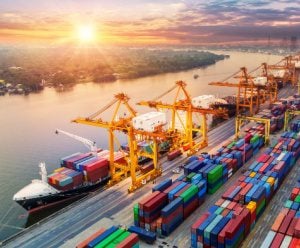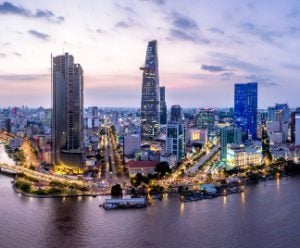
Supply chain diversification success starts with strategic partnerships

Across Asia Pacific, momentum in supply chain diversification is at an inflection point. In the face of ongoing geopolitical tensions, high inflation and interest rates, supply uncertainty, and an economic downturn in key markets such as China, companies of all sizes recognize that they need to recalibrate their supply chains to stay competitive.
As a result, some businesses are adopting friendshoring, nearshoring, and reshoring practices; establishing parallel supply chains; and employing dual sourcing. A new study reveals that a third of Asia Pacific business leaders are diversifying their firm’s supplier base in these ways.
However, global research on ‘the great supply chain reset’ shows that a piecemeal approach to boosting resilience and enhancing supply chain performance may not be enough. Rather than adjusting specific aspects of the supply chain, successful reassessment lies in more comprehensive end-to-end restructuring – from strategy and sourcing to manufacturing, packaging, storage, and transportation, including last-mile delivery options.
The opportunities for companies that get it right are significant: Asia Pacific’s exports and imports are projected to grow over 5 percent in 2024, making it the fastest-growing region globally.
So, how can Asia Pacific companies – from small businesses to multinational corporations – embrace a holistic approach to restructure their supply chains? What should they include in their strategic planning for resiliency?
Building a supply chain strategy on solid foundations
Taking an end-to-end approach to building more robust networks across markets requires companies to rethink where they operate, the materials they source, the suppliers they buy from, their production processes and operating model, and their physical supply footprint.
However, for companies of any size, the sheer scale and complexity of reorienting their supply chain model in these ways can be daunting. While commercial considerations like supplier cost, quality, and reliability are essential to setting up a supply chain, these are just a few components of the broader picture.
“Companies need to go much further in their calculations and consider any geopolitical and regulatory factors that may impact how their business operates,” says Raymond Yee, Asia Pacific Vice President for Customs & Regulatory Affairs, DHL Express. “In addition, could impending sanctions or export control rules be in the pipeline that might affect how you aim to do business with the U.S. or China, for example? It is about balancing risk and opportunity across multiple dimensions and jurisdictions.”
Conducting in-depth infrastructure assessments
Companies must also carefully assess the infrastructure of potential locations as they hone their diversification strategies. This allows them to better understand the risks associated with supply chain disruptions.
For example, evaluating the efficiency of a country’s transportation network can help companies accurately assess lead times and transportation costs. That, in turn, can help them optimize shipping routes and enable the smooth movement of goods across the supply chain. A detailed infrastructure assessment can also ensure company compliance with regulations related to issues such as energy efficiency – identifying areas where energy is being wasted, for example.
Research shows that understanding how to supercharge last-mile delivery options to reach customers efficiently – especially in diverse geographical areas – is another vital component of such an approach.
Last-mile delivery bridges the gap between the transportation hub (such as a warehouse or fulfillment center) and the customer’s doorstep. It is the critical step that directly influences customer satisfaction. It may involve strategic partnering with local delivery services, investing in logistics infrastructure, and implementing innovative delivery solutions such as drones and autonomous vehicles.
More importantly, the last-mile delivery should be in the initial planning, rather than an afterthought as the final fulfillment of the supply chain. It is an essential step that should be integrated into the overall supply chain diversification strategy, thus closing the loop with streamlined efficiency.
Understanding evolving customs practices
Companies seeking to refine their diversification strategies must stay informed about evolving global trade and customs regulations to ensure compliance, minimize the risk of supply chain disruption or optimize costs and efficiency.
There has been a significant increase in cross-border goods purchased via e-commerce platforms which are now presenting itself as a challenge to customs authorities. However, a holistic approach to regulating e-commerce is required; e-commerce also presents a significant opportunity for small and medium enterprises to enter the global market to sell their wares.
Besides this, the World Trade Organization (WTO) moratorium on e-commerce tariffs, agreed since 1988, is expected to end. WTO predicts that the first customs duties on digital products such as software downloads and online films will impact businesses in 2026, when the moratorium expires.
Other upcoming changes include the Carbon Border Adjustment Mechanism, a proposed European Union (E.U.) tariff on carbon-intensive products such as cement, electricity, iron, steel, and fertilizers. However, its scope could also extend to indirect emissions, potentially increasing the cost of exporting to the E.U. across a broader range of goods and services.
Providing visibility across the supply chain
As Yee points out, customs agencies are also implementing more stringent safety and security screening procedures at borders to prevent the movement of illicit goods, including counterfeit products.
“Customs authorities are now becoming far more focused on enforcing trade compliance regulations to ensure that imports and exports comply with regulatory requirements,” he said.
For example, amid growing awareness of human rights issues related to supply chains, such as forced labor and child labor, customs agencies, as seen in some countries, may seek to enforce regulations on these issues by inspecting shipments and ensuring that products are not produced under exploitative conditions.
“Given these increasing demands for transparency and accountability, it’s more important than ever that companies can provide visibility across the whole supply chain and demonstrate adherence to regulations and ethical sourcing practices, although this will no doubt be challenging,” says Yee.
Taking advantage of solid trade connectivity
Despite changing supply chain dynamics, new research from DHL highlights that trade connectivity remains in robust health. As the DHL Global Connectedness Report 2024 shows, ongoing efforts to strategically de-risk supply chains are helping to maintain strong global connectedness, with Asia Pacific poised to emerge as a critical hub for trade growth.
Companies can leverage free trade agreements (FTAs) to help diversify their supply chain. They can tap into new consumer bases by accessing markets with reduced trade barriers and expand their reach.
In Asia Pacific, the accelerating implementation of deals such as the ASEAN Free Trade Area is enhancing companies’ market access in these ways. Another key FTA is the Regional Comprehensive Economic Partnership (RCEP). Encompassing 30 percent of the world’s GDP and population, and including major Asian economies such as China, Indonesia, Japan, and South Korea, the RCEP is already enhancing growth prospects across the region.
Empowering supply chain management with relevant knowledge
To help them make the most of these opportunities as they diversify their networks, companies require a strong logistics partner that can provide guidance on the trade environment while also enhancing export capabilities.
Logistics firms such as DHL Express act as a knowledge hub for such trade and customs matters. For example, its AI-powered My Global Trade Services (myGTS) platform helps shippers easily retrieve customs information to pre-plan shipments as they access new markets. The free-to-use, self-serve online platform lets businesses compare trade lane regulations and requirements. “The new trade lane comparison capability helps SMEs enhance the understanding about customs requirements and landed cost. It aligns with our commitment to providing innovative solutions to help SMEs lower major trade barriers and become more confident in cross-border trade activities,” said Yung C. Ooi, Asia Pacific Senior Vice President for Commercial, DHL Express.
Enabling future growth
Supply chain diversification presents substantial opportunities for Asia Pacific companies to mitigate risks and strengthen their competitive position.
By understanding the wider factors shaping today’s dynamic global trade environment, they can make more informed decisions about where to operate and how to structure supply chains for resilience. Strategic partnerships will be crucial for effectively navigating the challenges of supply chain transformation and setting the foundation for long-term enterprise growth.
ALSO WORTH READING


















 English
English